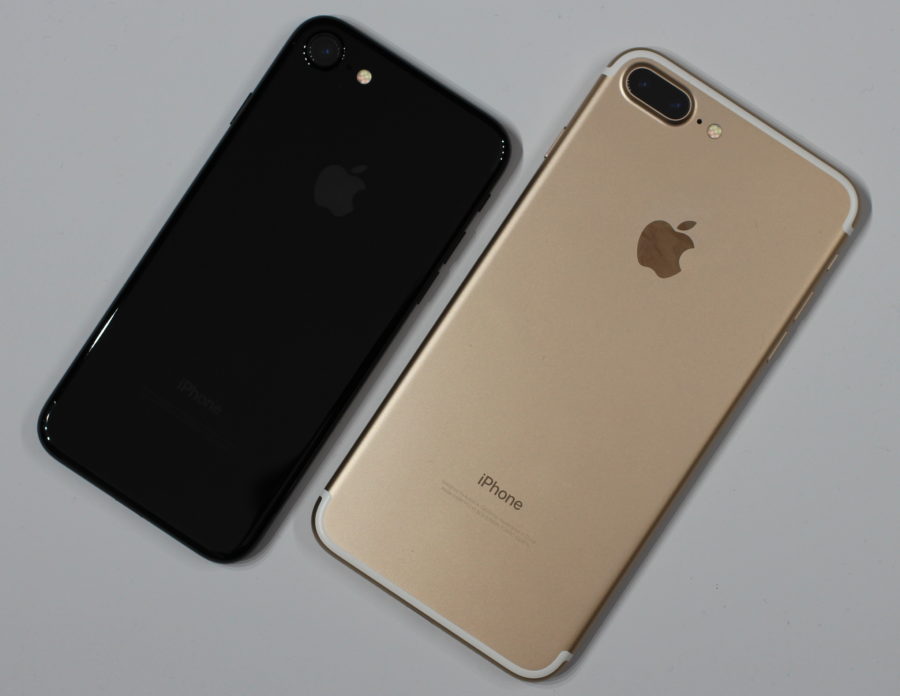By Eric Xue, News Editor
With the release of the iPhone 7 and 7 Plus in early September this year, high schoolers are faced once again with probably one of the most difficult questions faced by mankind: what phone should I get this year?
If you are still in the dark about which phone is best for you, don’t fret. This review has you covered, at least on the Apple side of things.
DESIGN
I’m not going to hide anything so I’ll say it right off the bat: the external design of the iPhone 7 and 7 Plus are disappointing. Putting the two new color choices aside, both models look exactly the same as their iPhone 6 counterparts, and even more so once you put on a case on them. The biggest difference in appearance I would say is in the antenna lines. On the iPhone 7 model, the antenna lines that surround the top and bottom are much less apparent than those on the iPhone 6 model, especially on the matte black and glossy jet black color models. The somewhat blending in of the antenna lines certainly gives the iPhone 7 a sleeker feel than the iPhone 6, but it’s nothing worth changing a phone for if you are solely considering appearance.

What the iPhone 7 and 7 Plus really have going for them is that they are water resistant. You won’t have to worry about damaging your new phone if you simply spilled something on it or if you accidentally dropped it into a sink. However, the new models are not waterproof, meaning you probably shouldn’t try to take underwater pictures with the fancy new cameras. But in all seriousness, you should try to stay away from bringing the 7 or 7 Plus near large bodies of water such as pools.
However, the most distinguishing difference in design of the iPhone 7 and 7 Plus is the removal of the headphone jack, or what I call Apple’s worst decision yet. If you want to listen to music on the new iPhone, you either have to use the dongle Apple provides to enable the use of traditional headphones or buy a pair of wireless headphones, whether it’s Apple’s for $159 or another brand’s. What’s even worse is the ease of losing the dongle Apple provides, which results in you having to buy them over and over again for $9 each. It doesn’t seem like much, but if you’re like me, it’ll amount to a hefty sum in the future. The headphone jack made listening and sharing music across the multitude of devices out there—iPhones, Androids, Macs, PCs, tablets, you name it—so much easier because all you had to do is plug and unplug your headphones when switching from device to device. Now, it takes much more effort to do so.
FUNCTIONALITY & PERFORMANCE
The Taptic Engine is a really nice feature of the iPhone 7 and fun to experience. The Taptic Engine is what Apple calls its haptic user interface feedback. It’s used in creating sensation in relaying notifications and reinforcing audio alerts as well as what I find to be the best use of it: simulating pressing the home button (just in case you forgot, the iPhone 7’s home button is not pressable, but rather it’s sensitive to pressure). The Taptic Engine really makes it feel like you are pressing down on a button instead of something solid.
The iPhone 7 and 7 Plus unsurprisingly have 3D Touch in their displays, which was around with the newer iPhone 6 models, but the display itself has improved. Although still nothing compared to the high display quality of certain Android phones, the display in the iPhone 7 is undoubtedly better than its iPhone 6 predecessor. The LCD is both sharper and brighter and show a wider spectrum of colors, which is noticeable in the photos.
Another thing you might notice is that much of the sound is coming from the earpiece instead of the usual location at the bottom of the phone. Both stereo speakers are louder but there aren’t any noticeable differences between audio quality of the iPhone 6 and 7.
The main difference between the iPhone 7 and 7 Plus (other than their sizes) is in their photo taking capabilities, but don’t get too excited, it’s not that big of a difference. The iPhone 7 and 7 Plus both have some minor improvements made from the iPhone 6 models: a faster f/1.8 lens, image stabilization, a four-way True Tone flash, and a wider range of color. These changes allow for better image taking capabilities but nothing extraordinary. However, the 7 Plus has a second camera, one that uses a f/2.8 lens. Both cameras operate simultaneously, but all that allows you to do is switch to a 2x zoom on a tap of a button. The front cameras were upgraded from a 5-megapixel sensor to a 7-megapixel sensor, allowing for sharper selfies.
The iPhone 7 and 7 Plus run on the new A10 Fusion chip, which has four cores: two high performance cores and two low performance cores to decrease battery consumption. The new models certainly are fast, but compared to the iPhone 6s with its A9 chip, it’s nothing to brag about.
OVERALL
The iPhone 7 and 7 Plus don’t offer enough to require a switch from the iPhone 6 and 6s models. The designs are similar, and the functionality of the phone has only improved a small amount. While the removal of the headphone jack was a really big turn-off for me, things like the Taptic Engine were really appealing.
Eric Xue can be reached at [email protected].





















































































